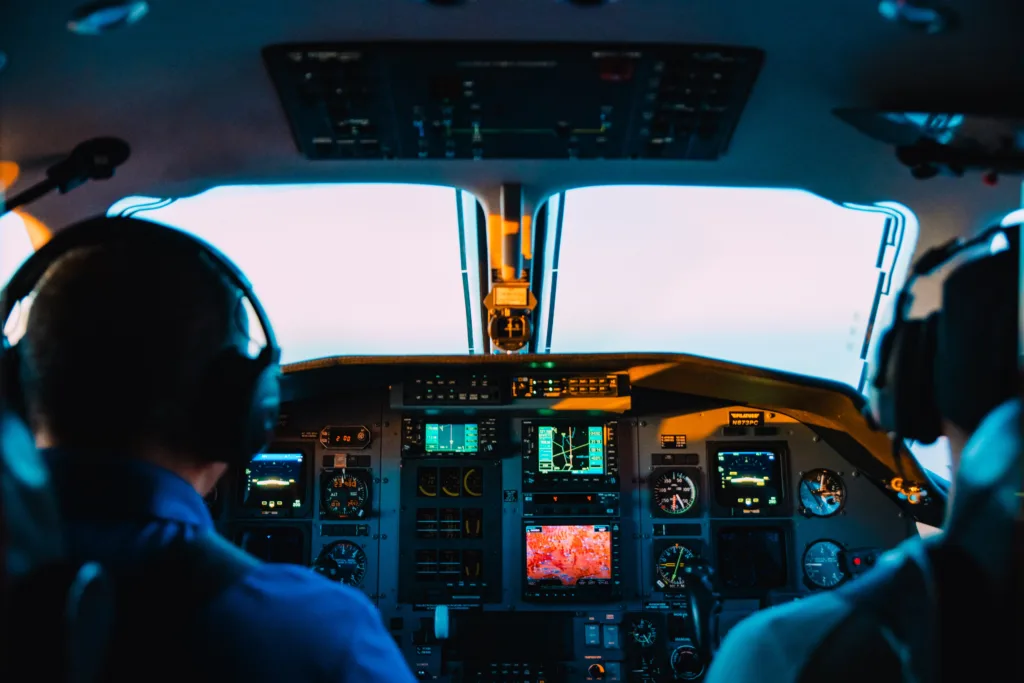A squawk code is a four-digit transponder code used by pilots to communicate with air traffic control (ATC) during a flight. It is a crucial tool for maintaining safety and efficiency in the skies. One particular squawk code that holds significant importance is “7700,” known as the emergency code.
When a pilot squawks 7700, it indicates that the flight is experiencing a serious emergency situation. This code serves as an immediate alert to ATC, informing them that the aircraft requires immediate assistance. It is the most well-known and widely recognized emergency code used in aviation.
In the event of an emergency, the crew will typically conduct necessary checks and procedures before formally declaring an emergency using the squawk code 7700. This allows them to assess the severity of the situation and take appropriate actions to ensure the safety of the passengers and the aircraft.
The squawk code 7700 is not the only code used for emergencies. There are two other codes that pilots may use: 7600 and 7500. The code 7600 is used when there is a communication failure between the aircraft and ATC. This could include issues with radio equipment or a loss of communication due to various factors. By squawking 7600, the pilot alerts ATC that they are unable to communicate effectively.
The code 7500, on the other hand, is used in cases of unlawful interference. If the flight is being hijacked or there is a threat of hijacking, the pilot will squawk 7500 to inform ATC of the situation. This allows ATC to coordinate with law enforcement agencies and take appropriate action to ensure the safety of all individuals involved.
It is important to note that squawk codes are not exclusive to emergencies. In fact, most of the time, pilots will be assigned a specific code by ATC for regular flight operations. These codes are used to identify and track individual aircraft in the airspace and maintain proper separation between flights.
For example, in the United States, a common squawk code for VFR (Visual Flight Rules) flights is 1200. This code indicates that the flight is operating under VFR and is not in direct contact with ATC. However, it is essential to remember that 1200 is a shared code, meaning that multiple aircraft may be transmitting it simultaneously in a given area.
Squawk codes are an integral part of aviation communication and safety. The emergency code 7700 is used to alert ATC of a serious emergency onboard a flight. Pilots may also use codes 7600 for communication failure and 7500 for unlawful interference. These codes help facilitate effective communication and coordination between pilots and ATC, ensuring the safety of all individuals involved in air travel.
What Does Squawking 7700 Mean?
Squawking 7700 is an emergency code used in aviation to communicate a critical situation onboard an aircraft. When a pilot “squawks” 7700, it alerts air traffic control and other aircraft in the vicinity that the flight is experiencing an emergency and requires immediate assistance.
The use of squawking 7700 is universally recognized as a distress signal, indicating that there is a potentially life-threatening situation onboard the aircraft. It is the most well-known emergency code and is understood by pilots, air traffic controllers, and aviation personnel worldwide.
To understand the meaning of squawking 7700, it is essential to comprehend the concept of transponders in aviation. A transponder is an electronic device installed in aircraft that transmits information such as altitude, speed, and identity to air traffic control radar systems. It also allows the aircraft to receive instructions and communicate with air traffic control.
The four-digit code entered into the transponder is called a squawk code. Squawk codes are used for various purposes, including identifying specific aircraft, indicating certain conditions, or declaring emergencies. Each code has a specific meaning, and squawking 7700 signifies an emergency.
When a pilot enters 7700 into the transponder, it indicates to air traffic control that the flight is facing a critical situation. This could include engine failure, severe weather conditions, medical emergencies, or any other circumstances that pose an immediate threat to the safety of the aircraft and its occupants.
Upon receiving the squawk code 7700, air traffic control takes immediate action to assist the aircraft in distress. They will prioritize the flight’s needs, provide guidance, and coordinate with relevant authorities to ensure a safe outcome.
It is worth noting that pilots typically conduct necessary checks and assessments before formally declaring an emergency by squawking 7700. This is to ensure that the situation genuinely warrants the use of the emergency code and to avoid unnecessary disruptions in air traffic.
Squawking 7700 is an emergency code used in aviation to signal a critical situation onboard an aircraft. It serves as a distress signal, alerting air traffic control and other aircraft of the immediate need for assistance.

What Are The 3 Emergency Squawk Codes?
The three emergency squawk codes used in aviation are as follows:
1. EMERGENCY – Mode 3A Code 7700: This code is used when an aircraft is experiencing an emergency situation. It signals to air traffic control and other aircraft that the aircraft is in distress and requires immediate assistance. In case an aircraft is already receiving air traffic service and transmitting a code, it may retain the code in use.
2. COMMS FAILURE – Mode 3A Code 7600: This code is used when there is a communication failure between the aircraft and air traffic control. It indicates that the aircraft is unable to establish or maintain radio communication. By squawking this code, the aircraft notifies air traffic control about the communication issue.
3. UNLAWFUL INTERFERENCE – Mode 3A Code 7500: This code is used to indicate that the aircraft is being subjected to unlawful interference, such as hijacking or unlawful seizure. By squawking this code, the pilots convey to air traffic control that the aircraft is under the control of unauthorized individuals and immediate action is required.
It’s important to note that using these squawk codes is a critical means of communication during emergency situations, ensuring that appropriate assistance can be provided to the aircraft in distress.
What Does It Mean To Squawk 1200?
When an aircraft “squawks 1200,” it refers to a specific transponder code used in aviation. Transponders are electronic devices that enable an aircraft to transmit information to air traffic control (ATC) radar systems. The code “1200” is specifically assigned to flights operating under Visual Flight Rules (VFR) in the United States.
Here is a breakdown of what it means to squawk 1200:
1. Visual Flight Rules (VFR): VFR is a set of regulations that govern how pilots operate their aircraft when visibility and weather conditions allow them to navigate by visual reference to the ground and other landmarks. Squawking 1200 indicates that the flight is operating under VFR and is not typically in direct contact with ATC.
2. Transponder Codes: A transponder is a device on the aircraft that responds to radar signals by sending back information about the flight, including its altitude and assigned code. Squawking refers to selecting or inputting a specific code into the transponder. In this case, the code is “1200.”
3. Shared Code: 1200 is a shared code, meaning it can be used by multiple aircraft simultaneously in a given area. This is common during VFR operations as there is no need for individual identification or separation services provided by ATC. However, ATC can still track and identify aircraft squawking 1200 through radar.
4. Safety Considerations: While squawking 1200, pilots are responsible for maintaining proper separation from other aircraft. They rely on their own visual scanning and communication with other pilots to avoid potential conflicts. It is important for pilots to remain vigilant and follow appropriate procedures to ensure safety during VFR flight.
Squawking 1200 indicates that an aircraft is operating under VFR in the United States. It is a shared transponder code used by multiple flights and allows ATC to track the aircraft’s position on radar. Pilots must adhere to VFR regulations and maintain proper separation from other aircraft while squawking 1200.
What Does Squawking 7500 Mean?
Squawking 7500 refers to a specific emergency code used in aviation to indicate that an aircraft has been hijacked. When a pilot enters the squawk code 7500 on their transponder, it is a signal to Air Traffic Control (ATC) that the aircraft is under the control of unauthorized individuals or that the crew is no longer in command.
The term “squawking” refers to the act of transmitting a specific code on the aircraft’s transponder. A transponder is a device that transmits information about the aircraft’s identity, altitude, and other crucial details to ATC radar systems. By entering the code 7500, the pilot is essentially notifying ATC that the plane is currently experiencing a hijacking situation.
In the event of a hijacking, the pilots may have been forced to change the aircraft’s course or may no longer be able to communicate directly with ATC. By squawking 7500, they are providing a silent distress signal to ATC, alerting them to the situation without directly communicating any information that could jeopardize the safety of those on board.
Once ATC receives the squawk code 7500, they will take immediate action to ensure the safety of the aircraft and its occupants. This typically involves coordinating with relevant authorities, such as law enforcement agencies, to initiate appropriate emergency procedures.
Squawking 7500 indicates a hijacking situation where the aircraft’s pilots are no longer in control or have been forced to change course. It serves as an emergency signal to ATC, allowing them to respond quickly and appropriately to ensure the safety of the aircraft and its passengers.

Conclusion
A squawk code is a four-digit transponder code used by pilots to communicate specific information to air traffic control (ATC). One of the most well-known squawk codes is Squawk 7700, which is used to indicate an emergency situation onboard a flight. This code is used to immediately notify ATC of any critical situation, such as engine failure, medical emergency, or any other life-threatening event.
Additionally, there are other squawk codes used for different purposes. For instance, Squawk 7600 is used to indicate a communication failure between the pilot and ATC, while Squawk 7500 is used to indicate an unlawful interference, such as a hijacking.
These squawk codes provide a quick and efficient way for pilots to convey vital information to ATC, allowing them to respond appropriately and provide necessary assistance. It is important for pilots to be familiar with these codes and understand when and how to use them in emergency situations.
Squawk codes serve as an essential communication tool in aviation, ensuring the safety of both the aircraft and its passengers. Pilots rely on these codes to quickly and accurately communicate emergencies, enabling ATC to take immediate action and provide necessary support.
